QR Zones of Green Cay Wetlands Boardwalk
Back to Introduction

 Follow this link to see a video presentation of this zone!
Follow this link to see a video presentation of this zone!
This zone contains some of the deepest and most open water spaces at Green Cay. Maximum depth is around 6 feet. Deep zones such as this support a variety of aquatic animal species, including fish, turtles, alligators and frogs. The deep open water area also allows for optimal ground water recharging because of the increased amount of water percolation. The predominant plant species found in deep zones is the spatterdock.
Plants: Spatterdock, American White Waterlilly, Big Floating Heart, Lotus.
Animals: Fish, Turtles, Frogs, Water Snakes, Alligator.
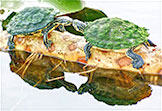
TURTLES – Green Cay is home to a variety of turtles such as the Red-Eared Slider, Florida Softshell, Mud, Red-Bellied and Peninsula Cooter. . A turtle’s shell is made of a protein called keratin. This is the same protein that makes up our hair and fingernails. The shell grows with the turtle throughout their life. When the turtle grows scutes are shed. If there are ridges on the shell or tail, they are called keels. Keels and scutes create the hard, armor-like texture of the shell that provides protection for the turtle. The top part of the shell is called the carapace, the bottom is called the plastron, and the connection between the two is called the bridge.
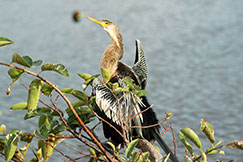
ANHINGA - A water bird of the warmer parts of the Americas. The word anhinga comes from the Brazilian Tupi language and means devil bird or snake bird. The Anhinga often swims with only the neck above water. When swimming in this style the name Snakebird is apparent, since only the colored neck appears above water the bird looks like a snake ready to strike. Unlike ducks, the Anhinga is not able to waterproof its feathers using oil produced by the uropygial gland. Consequently, feathers can become waterlogged, making the bird barely buoyant. However, this allows it to dive easily and search for underwater prey, such as fish and amphibians. It can stay down for significant periods. When necessary, the Anhinga will dry out its wings and feathers by perching for long periods with its wings spread to allow the drying process, as do cormorants. If it attempts to fly while its wings are wet, it has great difficulty getting off the water and takes off by flapping vigorously while "running" on the water.
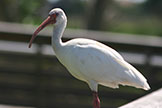
WHITE IBIS - Found from the mid-Atlantic and Gulf Coast of the United States south through most of the tropics. This particular ibis is a medium-sized bird with an overall white plumage, bright red-orange down-curved bill and long legs, and black wing tips that are usually only visible in flight. Males are larger and have longer bills than females. Their diet consists primarily of small aquatic prey, such as insects and small fishes. Crayfish are its preferred food in most regions; however, it can adjust its diet according to the habitat and prey abundance. It is a tactile, non-visual forager, whose main foraging behavior is probing with its beak at the bottom of shallow water to feel form, and to capture its prey.
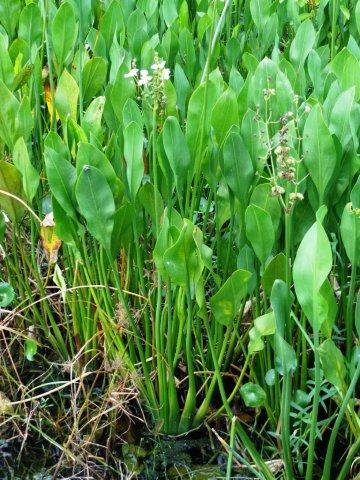
ARROWHEAD - An emersed plant. It's large leaves and conspicuous flowers make it easy to find in the wild. It grows commonly in swamps, ditches, lakes, and stream margins. Arrowhead is also called duck potato because of its potato-like, underground corms that sometimes form. Duck potato has large, firm, lance-shaped leaves, which are typically four inches wide and up to two feet long. Also called Duck Potato.
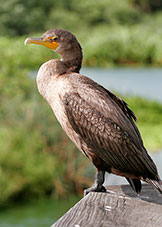
DOUBLE-CRESTED CORMORANTS - The most widespread cormorant in North America, and the one most frequently seen in freshwater. They breed on the coast as well as on large inland lakes. They form colonies of stick nests built high in trees on islands or in patches of flooded timber. Double-crested Cormorants float low on the surface of water and dive to catch small fish. After fishing, they stand on docks, rocks, and tree limbs with wings spread open to dry. In flight, they often travel in V-shaped flocks that shift and reform as the birds alternate bursts of choppy flapping with short glides. Cormorants often stand in the sun with their wings spread out to dry. They have less preen oil than other birds, so their feathers can get soaked rather than shedding water like a duck’s. Though this seems like a problem for a bird that spends its life in water, wet feathers probably make it easier for cormorants to hunt underwater with agility and speed.
Green Cay Nature Center and Wetlands is owned and operated by the
Palm Beach County Parks and Recreation Department and the
Water Utilities Department.
 OTHER LANGUAGES
OTHER LANGUAGES
 OTHER LANGUAGES
OTHER LANGUAGES